Статьи журнала - International Journal of Intelligent Systems and Applications
Все статьи: 1126
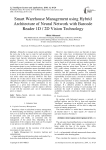
Статья научная
Manually, to manage stocks amounts spending the every day in the rays to count for each product the number which it remains in stores, or to record by a scanner head barcode information dependent of each product. However, the mission become increasingly difficult if several warehouses are found, that involves much time to pass from a product to another, moreover that requires agents to carry out these spots. In this article we use a network architecture neuron combined with the readers bar code of technology vision, this method allows to know in real time information concerning each product in stock. It will allow besides introducing the concept of real stocks rather than physical. However The basic classical use of data and to feed it will be completely changed by the spheres of knowledge which generates the NN (Neural Network) to store information on the quantity at a given time (Dynamic inventory), the entries(delivery of suppliers ) and the outputs ( delivery or sale with the customers and use of manufacturing pieces or repair ).
Бесплатно
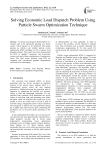
Solving Economic Load Dispatch Problem Using Particle Swarm Optimization Technique
Статья научная
Economic load dispatch (ELD) problem is a common task in the operational planning of a power system, which requires to be optimized. This paper presents an effective and reliable particle swarm optimization (PSO) technique for the economic load dispatch problem. The results have been demonstrated for ELD of standard 3-generator and 6-generator systems with and without consideration of transmission losses. The final results obtained using PSO are compared with conventional quadratic programming and found to be encouraging.
Бесплатно
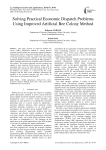
Solving Practical Economic Dispatch Problems Using Improved Artificial Bee Colony Method
Статья научная
This paper presents an improved artificial bee colony (IABC) optimization method to solving practical economic dispatch taking into account the nonlinear generator characteristics such as valve-point loading effects. In order to exploit the performance of this new variant based ABC method to solving practical economic dispatch, a new local search mechanism (LSM) associated to the original ABC algorithm; it allows exploiting effectively the promising region to locate the best solution. The proposed approach has been examined and applied to many practical electrical power systems, the 13 generating units, and to the large electrical system with 40 generating units considering valve point loading effects. From the different case studies, it is observed that the results compared with the other recent techniques demonstrate the potential of the proposed approach and show clearly its effectiveness to solve practical and large ED.
Бесплатно
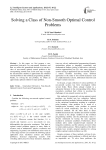
Solving a Class of Non-Smooth Optimal Control Problems
Статья научная
In this paper, we first propose a new generalized derivative for non-smooth functions and then we utilize this generalized derivative to convert a class of non-smooth optimal control problem to the corresponding smooth form. In the next step, we apply the discretization method to approximate the obtained smooth problem to the nonlinear programming problem. Finally, by solving the last problem, we obtain an approximate optimal solution for main problem.
Бесплатно
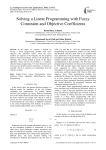
Solving a Linear Programming with Fuzzy Constraint and Objective Coefficients
Статья научная
In this paper, we consider a method for solving a linear programming problem with fuzzy objective and coefficient matrix, where the fuzzy numbers are supposed to be triangular. By the proposed method, the Decision Maker will have the flexibility of choosing. The solving method is based on the Pareto algorithm, which converts the problem to a weighted-objective linear programming. For more illustration, after discussing the problem and the algorithm, we present an example, which its solutions are independent from the objective weights.
Бесплатно
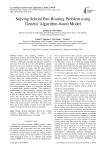
Solving school bus routing problem using genetic algorithm-based model
Статья научная
School Bus Routing Problem is an optimization problem which falls under the class of the Vehicle Routing Problem. It involves the use of a fleet of vehicles to efficiently and optimally transport students to and from their schools. To solve this problem, optimal school bus routes are found by minimizing the number of buses, the number of routes and the total distance traversed along all routes. Manual routing of school buses have led to creation of many routes, increased number of buses and several buses navigating the same route, thereby incurring more cost. One of such methods used in solving school bus routing problems is meta-heuristic method which has proven better results in terms of optimal solution and reduced time complexity. In this study, Genetic algorithm is utilized to solve the school bus routing problem because of its simplicity and ability to generate many possible solutions. The algorithm is implemented in C# programming language and tested using secondary data obtained from Ondo State Free-School Bus Shuttle Scheme, Akure, Nigeria. The result shows that of all four nodes (bus stops) used in performance evaluation, Alakure to Oke-Aro junction bus stop presents as the best route which covers a total of 69 nodes with a total distance of 34.5km. This shows that there can be less number of buses in use and reduced number of routes in which the buses are assigned.
Бесплатно
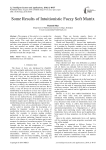
Some Results of Intuitionistic Fuzzy Soft Matrix
Статья научная
The purpose of this article is to consider the notions of intuitionistic fuzzy soft matrices and some basic results. This work deals particularly with the definition of transpose of intuitionistic fuzzy soft matrices and then some properties of transpose of intuitionistic fuzzy soft matrices are studied. After that symmetric intuitionistic fuzzy matrices are also defined and some properties are discussed. Numerical examples are provided to make the concept clear.
Бесплатно
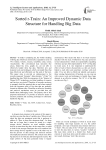
Sorted r-Train: an improved dynamic data structure for handling big data
Статья научная
In today’s computing era, the world is dealing with big data which has enormously expanded in terms of 7Vs (volume, velocity, veracity, variability, value, variety, visualization). The conventional data structures like arrays, linked list, trees, graphs etc. are not able to effectively handle these big data. Therefore new and dynamic tools and techniques which can handle these big data effectively and efficiently are the need of the hour. This paper aims to provide an enhancement to the recently proposed “dynamic” data structure “r-Train” for handling big data. With the emergence of the “Internet of Things (IoT)” technology, real-time handling of requests and services are pivotal. Therefore it becomes necessary to promptly fetch the required data as and when required from the enormous piles of big data that are generally located at different sites. Therefore an effective searching and retrieval mechanism must be provided that can handle these challenging issues. The primary aim of this proposed refinement is to provide an effective means of insertion, deletion and searching techniques to efficiently handle the big data.
Бесплатно
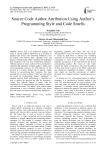
Source Code Author Attribution Using Author's Programming Style and Code Smells
Статья научная
Source code is an intellectual property and using it without author's permission is a violation of property right. Source code authorship attribution is vital for dealing with software theft, copyright issues and piracies. Characterizing author's signature for identifying their footprints is the core task of authorship attribution. Different aspects of source code have been considered for characterizing signatures including author's coding style and programming structure, etc. The objective of this research is to explore another trait of authors' coding behavior for personifying their footprints. The main question that we want to address is that "can code smells are useful for characterizing authors' signatures? A machine learning based methodology is described not only to address the question but also for designing a system. Two different aspects of source code are considered for its representation into features: author's style and code smells. The author's style related feature representation is used as baseline. Results have shown that code smell can improves the authorship attribution.
Бесплатно
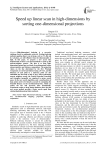
Speed up linear scan in high-dimensions by sorting one-dimensional projections
Статья научная
High-dimensional indexing is a pervasive challenge faced in multimedia retrieval. Existing indexing methods applying linear scan strategy, such as VA-file and its variations, are still efficient when the dimensionality is high. In this paper, we propose a new access idea implemented on linear scan based methods to speed up the nearest-neighbor queries. The idea is to map high-dimensional points into two kinds of one-dimensional values using projection and distance computation. The projection values on the line determined by the first Principal Component are sorted and indexed using a B+-tree, and the distances of each point to a reference point are also embedded into leaf node of the B+-tree. When performing nearest neighbor search, the Partial Distortion Searching and triangular inequality are employed to prune search space. In the new search algorithm, only a small portion of data points need to be linearly accessed by computing the bounded distance on the one-dimensional line, which can reduce the I/O and processor time dramatically. Experiment results on large image databases show that the new access method provides a faster search speed than existing high-dimensional index methods.
Бесплатно
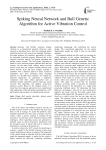
Spiking neural network and bull genetic algorithm for active vibration control
Статья научная
Systems with flexible structures display vibration as a characteristic property. However, when exposed to disturbing forces, then the component and/or structural nature of such systems are damaged. Therefore, this paper proposes two heuristics approaches to reduce the unwanted structural response delivered due to the external excitation; namely, bull genetic algorithm and spiking neural network. The bull genetic algorithm is based on a new selection property inherited from the bull concept. On the other hand, spiking neural network possess more than one synaptic terminal between each neural network layer and each synaptic terminal is modelled with a different period of delay. Extensive simulations have been conducted using simulated platform of a flexible beam vibration. To validate the proposed approaches, we performed a qualitative comparison with other related approaches such as traditional genetic algorithm, general regression neural network, bees algorithm, and adaptive neuro-fuzzy inference system. Based on the obtained results, it is found that the proposed approaches have outperformed other approaches, while bull genetic algorithm has a 5.2% performance improvement over spiking neural network.
Бесплатно
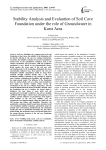
Статья научная
Soil cave foundation is a common type in the soil foundation in karst area, the stability of the foundation will be directly affected by the soil cave collapse destruction. Currently, the stability evaluation of soil cave foundation is mostly focus on the quantitative evaluation, such as the collapse mechanism and prevention, while the qualitative assessment is rare. Based on the plastoelasticity theory, firstly analyze the stress state of the soil cave wallsurrounding body in the foundation, distinguish the stress concentration influence area, then improve the soil cave foundation stability computation model by using Molecoulomb strength criterion, finally, take a soil cave foundation stability evaluation as the example in Tongren area, Guizhou, confirming the feasibility and reliability of the improvement model. The influence of the foundation bed size, buried depth, soil cave shape and groundwater level depth was further studied, which reveals the mechanism of the soil cave collapse destruction. And the research indicated that the improved model is feasible, when the foundation bed size is smaller, the buried depth is shallower, the hole shape is more spiky and the groundwater level depth is shallower, the soil cave stability coefficient will be bigger, which is more advantageous to the stability, and the influence of groundwater level depth is more sensitive to the soil cave stability, once the groundwater level depth dropped a little, the stable soil cave will become into failure and instability. Therefore, the quantitative evaluation should be paid more attention in soil cave foundation stability evaluation, particularly under the ground water environment, simultaneously, the calculation results, like soil cave foundation maximum size, the critical buried depth, the maximum water level buried depth, have the strong directive function to the soil cave foundation treatment and design.
Бесплатно
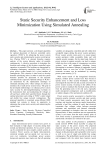
Static Security Enhancement and Loss Minimization Using Simulated Annealing
Статья научная
This paper presents a developed algorithm for optimal placement of thyristor controlled series capacitors (TCSC’s) for enhancing the power system static security and minimizing the system overall power loss. Placing TCSC’s at selected branches requires analysis of the system behavior under all possible contingencies. A selective procedure to determine the locations and settings of the thyristor controlled series capacitors is presented. The locations are determined by evaluating contingency sensitivity index (CSI) for a given power system branch for a given number of contingencies. This criterion is then used to develop branches prioritizing index in order to rank the system branches possible for placement of the thyristor controlled series capacitors. Optimal settings of TCSC’s are determined by the optimization technique of simulated annealing (SA), where settings are chosen to minimize the overall power system losses. The goal of the developed methodology is to enhance power system static security by alleviating/eliminating overloads on the transmission lines and maintaining the voltages at all load buses within their specified limits through the optimal placement and setting of TCSC’s under single and double line outage network contingencies. The proposed algorithm is examined using different IEEE standard test systems to shown its superiority in enhancing the system static security and minimizing the system losses.
Бесплатно
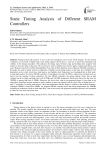
Static Timing Analysis of Different SRAM Controllers
Статья научная
Timing-critical path analysis is one of the most significant terms for the VLSI designer. For the formal verification of any kinds of digital chip, static timing analysis (STA) plays a vital role to check the potentiality and viability of the design procedures. This indicates the timing status between setup and holding times required with respect to the active edge of the clock. STA can also be used to identify time sensitive paths, simulate path delays, and assess Register transfer level (RTL) dependability. Four types of Static Random Access Memory (SRAM) controllers in this paper are used to handle with the complexities of digital circuit timing analysis at the logic level. Different STA parameters such as slack, clock skew, data latency, and multiple clock frequencies are investigated here in their node-to-node path analysis for diverse SRAM controllers. Using phase lock loop (ALTPLL), single clock and dual clock are used to get the response of these controllers. For four SRAM controllers, the timing analysis shows that no data violation exists for single and dual clock with 50 MHz and 100 MHz frequencies. Result also shows that the slack for 100MHz is greater than that of 50MHz. Moreover, the clock skew value in our proposed design is lower than in the other three controllers because number of paths, number of states are reduced, and the slack value is higher than in 1st and 2nd controllers. In timing path analysis, slack time determines that the design is working at the desired frequency. Although 100MHz is faster than 50MHz, our proposed SRAM controller meets the timing requirements for 100MHz including the reduction of node to node data delay. Due to this reason, the proposed controller performs well compared to others in terms slack and clock skew.
Бесплатно
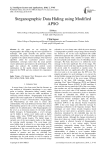
Steganographic Data Hiding using Modified APSO
Статья научная
In this paper we are analyzing the steganographic data hiding using the least significant bit technique. This paper describes the particle swarm optimisation. The particle swarm optimisation algorithm is applied to the spatial domain technique. The improved algorithm called the accelerated particle swarm optimisation converges faster than the usual particle swarm optimisation and improves the performance. This paper also analyses the modified particle swarm optimisation on the spatial domain technique which improved the PSNR and also reduced the computation time.
Бесплатно
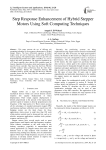
Step Response Enhancement of Hybrid Stepper Motors Using Soft Computing Techniques
Статья научная
This paper presents the use of different soft computing techniques for step response enhancement of Hybrid Stepper Motors. The basic differential equations of hybrid stepper motor are used to build up a model using MATLAB software package. The implementation of Fuzzy Logic (FL) and Proportional-Integral-Derivative (PID) controllers are used to improve the motor performance. The numerical simulations by a PC-based controller show that the PID controller tuned by Genetic Algorithm (GA) produces better performance than that tuned by Fuzzy controller. They show that, the Fuzzy PID-like controller produces better performance than the other linear Fuzzy controllers. Finally, the comparison between PID controllers tuned by genetic algorithm and the Fuzzy PID-like controller shows that, the Fuzzy PID-like controller produces better performance.
Бесплатно
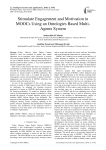
Stimulate Engagement and Motivation in MOOCs Using an Ontologies Based Multi-Agents System
Статья научная
Today, Massive Open Online Courses (MOOCs) have the potential to enable free online education on an enormous scale. However, a concern often raised about MOOCs is the consistently high drop-out rate of MOOC learners. Although many thousands of learners enroll on these courses, a very small proportion actually complete the course. This work is at the heart of this issue. It is interested in contributing on multi-agents systems and ontologies to describe the learning preferences and adapt educational resources to learner profile in MOOCs platforms. The primary aim of this work is to exploit the potential of multi-agents systems and ontologies to improve learners' engagement and motivation in MOOCs platforms and therefore reduce the drop-out rates. As part of the contribution of this work, the paper proposes a model of Multi-Agent System (MAS), based on ontologies for adapting the learning resources proposed to a learner in a MOOCs platform according to his learning preferences. To model an adequate online course, the determination of learner's preferences is done through the analysis of learner behavior relying on his indicator MBTI (Myers Briggs Type Indicator). The proposed model integrates the main functionalities of an intelligent tutoring system: profiling, updating of the profile, selection, adaptation and presentation of adequate resources. The architecture of the proposed system is composed on two main agents, four ontologies and a set of modules implemented.
Бесплатно
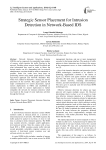
Strategic Sensor Placement for Intrusion Detection in Network-Based IDS
Статья научная
Network Intrusion Detection Systems (NIDSs) can be composed of a potentially large number of sensors, which monitor the traffic flowing in the network. Deciding where sensors should be placed and what information they need in order to detect the desired attacks can be a demanding task for network administrators, one that should be made as automatic as possible. Some few works have been done on positioning sensors using attack graph analysis, formal logic-based approach and Network Simulator NS2 which were studied to determine a strategy for sensors placement on the network. This paper analysed the major considerations for sensors placements, typical sensors deployments in NIDS, and established an extended model for sensors deployment to further strengthen the network for intrusion detection which was based on the escape of some malicious activities through the firewall.
Бесплатно
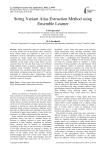
String Variant Alias Extraction Method using Ensemble Learner
Статья научная
String variant alias names are surnames which are string variant form of the primary name. Extracting string variant aliases are important in tasks such as information retrieval, information extraction, and name resolution etc. String variant alias extraction involves candidate alias name extraction and string variant alias validation. In this paper, string variant aliases are first extracted from the web and then using seven different string similarity metrics as features, candidate aliases are validated using ensemble classifier random forest. Experiments were conducted using string variant name-alias dataset containing name-alias data for 15 persons containing 30 name-alias pairs. Experimental results show that the proposed method outperforms other similar methods in terms of accuracy.
Бесплатно
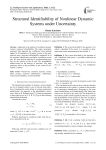
Structural Identifiability of Nonlinear Dynamic Systems under Uncertainty
Статья научная
Approach to the analysis of nonlinear dynamic systems structural identifiability (SI) under uncertainty proposed. This approach has a difference from methods applied to SI estimation of dynamic systems in the parametrical space. Structural identifiability interpreted as of the structural identification possibility a nonlinear system part. We show that the input has S-synchronization property for the solution of the SI task. The identifiability method based on the analysis of structures. The input parameter effect on the possibility of the system SI estimation is studied.
Бесплатно

